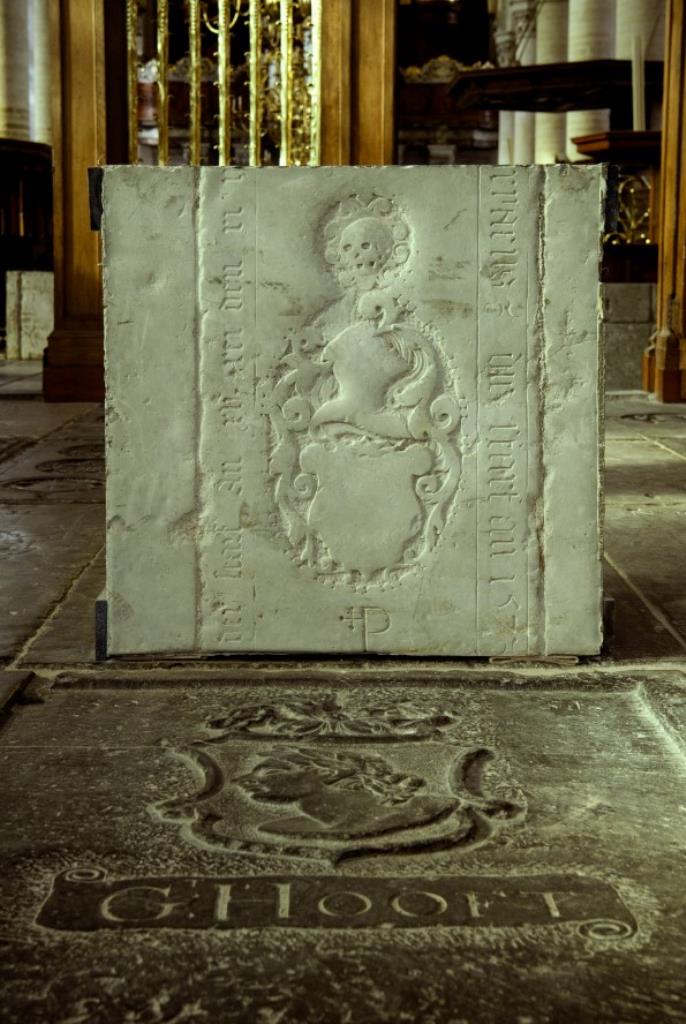
The installation Garden of Scars, created by Ibrahim Mahama at the Oude Kerk for his first solo exhibition in the Netherlands, included sculpture, drawings, sound, and film. It was about the intertwined history of Amsterdam and Ghana where Mahama has set up numerous cultural and social projects that provide employment and creative education to local people.
Mahama considers the tombstones that cover the 3.000 square metre floor of the Oude Kerk as a form of collective memory. After years of erosion, they have become smooth surfaces which heightened Mahama's attention for the traces of history and memory. In his words: ‘A tombstone is like a scar on your skin; it takes your mind back to a specific moment in time. In a way, it is a kind of teleportation device. While it often looks ugly, I also find a certain beauty in how it allows our minds to travel and access different points in memory.’
Scattered across the floor were hundreds of concrete sculptures, casts of tombstones from both the Oude Kerk and Mahama's hometown of Tamale in Ghana. Remnants of domestic objects protruded from the sides which were collected by Mahama door-to-door in villages in Ghana, among them wooden furniture and metal lamps. They were personal, everyday objects, symbols of home that also recalled a global colonial history. Other objects also lay among the stones, such as rubber moulds made of stones from Ussher Fort in Jamestown, Ghana, a former Dutch fort and prison. They lay on the floor and seemed intertwined with it. You could walk over them like any tombstone in church. In a few places, the rubber moulds were draped over the concrete sculptures. At the far edges of the work, you could see a white grave from Ghana and a large cross. At the very top of the church, directly under the roof vault, hung over 1.500 bats, associated with rebirth and wisdom in many cultures outside of the West. Large charcoal drawings had been hung on the walls. Mahama thus made visible a shared history and highlighted the global networks linked to both places.
The use of bats in Mahama's work has its origins in Tamale. When Mahama purchased an abandoned silo (Nkruma Voli-ni) as part of his larger plan to provide for a new institutional cultural development in Ghana, he discovered that bats lived in the building. He decided to protect them and give them their own space as co-inhabitants of the building. Bats are creatures of the night, and this association has linked them to death, evil, negativity, and witches. But while the Western world sees bats in this negative light, in many cultures bats often represent mortality in the sense of letting go of the old and bringing in the new. They are symbols of transition, initiation, and the beginning of something new. The bats being hung in the church was also a reference to the Oude Kerk's redevelopment into one of Amsterdam's youngest spaces for contemporary art.
Five speakers were hidden in the church’s nave. If visitors wandered through the nave, they could hear five different impressions from Mahama’s working process. These included the soft sounds of water dropping in the silo Nkruma Voli-ni in Tamale, part of the Red Clay Studio complex; the sounds of scraping and people working on new infrastructures near the silo; snippets from a conversation on the trains that were acquired during the preparation for the installation in the Oude Kerk, the exciting beginning of a new project; the sounds of an engine and someone welding metal when people were working on the trains; the sounds of birds from sacred shrines in Tamale, places where ancestors are buried but that are left abandoned, slowly reclaimed by nature.
Mahama's installation was inspired significantly by the Oude Kerk's tombstone floor. He therefore wanted to have the stones and their adornments to be 'traced': to make a copy by placing a sheet of paper on the tombstone and rubbing it with charcoal. He used these covers to create the sculptural elements in his work - casts of the stones from the Oude Kerk and from various locations in Ghana, rising above the monument's floor - as well as for the monumental drawings hung in several of the church's niches. During a weekend in June, visitors were invited to help make these rubbings in preparation of Garden of Scars. Almost two hundred rubbings were made.
The 1m-high memorial stones varied in shape and size, sometimes a square, sometimes a rectangle or cross. Mahama found inspiration for these sculptural forms in the collection of memorial stones he found in a cemetery in Tamale. A place he had bought shortly before. Formed out of the soil in Ghana, the sculptures were heavy with the geological past of places along the coast. The soil consists of a mix of local and imported materials, haunted by the ghosts of a connected history. The sculptures showed imprints of gravestones in the Oude Kerk and of the walls and floors of forts in Ghana. A site visit, including Cape Coast Castle, Fort Prinzenstein Keta, St George's Castle Elmina, and Usser Fort Accra, took place in the run-up to the installation. The production of the sculptures took place at his Red Clay studio in Tamale. On site, Mahama collaborated with over 100 students, artists and craftsmen from the area.

